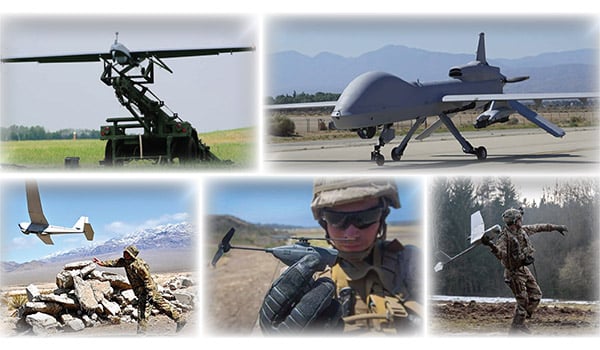
CWOB Update / By CW5 Frank Volpe: Prior to 9/11, the Army only had corps-level Hunter UAS. These ~two dozen aircraft were equipped with basic electro optical/ infra-red (EO/IR) capability and operated well above the coordinating altitude in restricted/combat airspace with little to no impact on rotary wing Aviation.

VISUAL BY ANNE EWING
Fast forward to today; UAS has grown to well over 8,000 aircraft of varying sizes comprised of both programs of record (PORs) and non-standard commercial off the shelf (COTS) systems. These UAS support maneuver units from 100ft Above Highest Obstacle (AHO) to 25,000 ft. MSL in both the National Airspace (NAS) and in combat. The bulk of this increase are small unmanned aircraft systems (sUAS) of < 55lbs., which over the next five years will swell to over 20,000 aircraft when the Army fields the new sUAS Short Range Reconnaissance (SRR), Long Range Reconnaissance (PUMA replacement) and over 10,000 Soldier Borne Sensors (SBS).
Deconflicting and Integrating
During the last 18 years of the COIN fight, we achieved effective UAS integration by de-conflicting manned / unmanned aircraft via vertical separation (altitude) and the use of Restricted Operating Zones (ROZs) for separation in time. This was an adequate process while operating from a fixed base configuration. Soldiers learned to activate pre-coordinated ROZs for sUAS below the coordinating altitude and used kill boxes and keypads above the coordinating altitude for larger UASs. These current procedures may not be adequate for airspace deconfliction in more complex Multi Domain Operations (MDO) with discussions ongoing in several airspace working groups. The challenges of enemy Integrated Air Defense Systems (IADS), enemy UAS, the exponential growth of DoD sUAS, and the introduction of Air Launched Effects (ALE) coupled with manned RW aviation pushing down to lower altitudes for survivability will strain an already congested airspace. In addition to the increased complexity of manned/unmanned systems operating in closer proximity, the electromagnetic environmental effects on Army communications, navigation, and targeting systems will further contribute to these synchronization challenges. How we command and fight Army Aviation operations in Large Scale Combat Operations (LSCO) is more than just avoiding running into each other. It’s about achieving the simultaneity of operations that allows us to fly and fight while defeating adversary threat UAS / counter-UAS and manned aviation.
Setting Conditions
For example, during the competition phase, the Army must actively engage across domains (including space and cyberspace), in the electromagnetic spectrum (EMS), and in the information environment to set the conditions that enable the Joint Force’s rapid transition to armed conflict. Our large UAS are uniquely suited for this competition; they can deploy all over the world without risk to the Soldier or need for dedicated large boots on the ground presence. They are optimized for long endurance and provide a persistent presence. They are cost efficient; even our most advanced UAS costs are modest when compared to larger turbine powered aircraft. Modernization efforts will continue to build on these capabilities improving unmanned systems / sensors with greater range (standoff), flight in the national/international airspace with reduced ground footprint that enables tactical /strategic movement, all while improving their survivability.
Having set the conditions during the competition phase, the Army must be able to penetrate, dis-integrate, and exploit the enemy. During the penetration phase, UAS will leverage the deep sensing / penetration payloads, which provide targeting data, and generate multiple dilemmas with the use of air launched effects (ALE) that include both lethal and non-lethal systems. Having exploited the vulnerabilities of enemy IADS, UAS and ALE coupled with Long Range Precision Fires (LRPF) and manned platforms are optimized to dis-integrate (destroy) the enemy’s stand-off capabilities, prevent the re-integration of remaining capabilities, and enable freedom of maneuver. Army forces at echelon employ cross-domain fires to defeat the enemy’s long-range systems and begin the neutralization of the enemy mid-range systems. Convergence optimizes the employment of capabilities across all domains, to stimulate, see, and strike the enemy. This allows the Joint Force continued exploitation and destruction of enemy IADS to ultimately achieve campaign objectives. This complex environment presents never experienced challenges to the joint force to deconflict both ground and air, manned and unmanned assets in an ever-changing environment. As we have in the past, the military will remain agile and adaptive adjusting to these challenges with additional training, systems and automation.
Now more than in any point in our over 30+ year history, the future of Army Aviation includes unmanned systems. Army forces and partners will employ layered UAS, both organic and joint, to develop an understanding of the enemy’s attack and their capabilities. The proliferation of UAS on the modern battlefield, coupled with improved man-machine interfaces and advanced teaming requires the Army to attract, train, retain, and employ leaders and Soldiers who collectively possess a significant breadth and depth of technical and professional expertise. Army aviation is more lethal, effective and committed today than ever in support of the ground commander, and we will only become more lethal.







